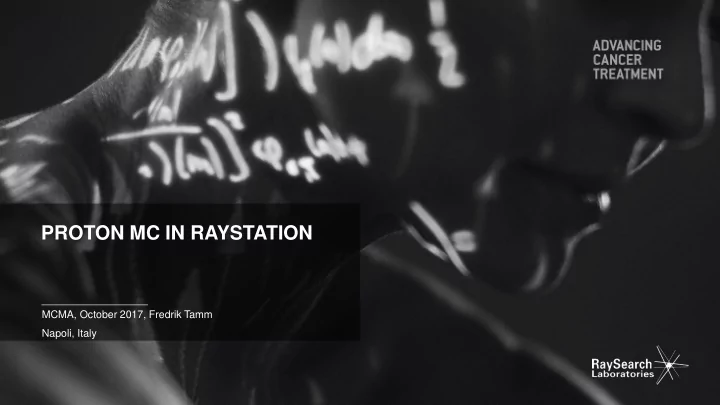

PROTON MC IN RAYSTATION MCMA, October 2017, Fredrik Tamm Napoli, Italy
RAYSTATION ■ RayStation TPS for photons, electrons, protons and carbon ions ■ Around 40 proton clinics ■ Proton MC relased in december 2016 in Raystation 6 for PBS.
WHY MONTE-CARLO IN A TPS? ■ Significant lateral inhomogeneities – Lung ■ Range shifters – Errors up to 10% in the surface region with PBA for very large air gaps – Secondary ions over air gap ■ Block apertures – Edge scatter effects ■ Large or small field sizes
WHAT IS REQUIRED OF A MONTE-CARLO IN A TPS? ■ Need to be able to optimize plans with the MC dose engine ■ Compute dose to uncertainty ■ Must be fast ■ Must also be accurate Sensible tradeoffs between speed and accuracy are essential! Q: Which physics needs to be modelled and how?
PHYSICS RATIONAL FOR FAST PROTON MONTE CARLO • First order phenomena: • Ionization energy loss - Range to the distal edge of the Bragg peak • Multiple scattering - Penumbra, amplitude at Bragg peak • Nuclear absorption - Amplitude at Bragg peak • Secondary ions - Field size dependence
PHYSICS CONTINUED • Second order phenomena: • Delta electrons - Range <1mm • Heavier secondary ions - Range <1mm • Gammas and neutrons - Very diffuse dose distribution
TRANSPORT MECHANICS • Multiple scattering and energy straggling over random hinge steps • Energy loss and nuclear reactions at each voxel • Secondary protons, deuterons and alphas are transported. • Dose from heavier ions deposited locally • Gammas and neutrons ignored
MATERIAL AND GEOMETRY HANDLING • Nuclear cross sections from ICRU63 • Same stopping power and material handling as in the Pencil Beam dose engine • Material composition determined from CT- data • Same physics and transports in all geometries (patient, range shifter, block etc)
IMPLEMENTATION DETAILS ■ On CPU ■ Xoroshiro128+ random number generator ■ Same phase space for Pencil Beam and Monte Carlo -> same machine model can be used ■ Phace space described by two gaussians and an energy spectra ■ Score dose-to-water
MC RESULTS – LUNG ■ Experimental study from Seattle Jatinder Saini et al,, Phys.Med. Biol 62 (2017) 7659-7681
EFFECTS OF INHOMOGENEITIES - MC VS. MEASUREMENTS Sorriaux - Physica Medica - European Journal of Medical Physics; EJMP-D-17-00087
MC RESULTS – RANGE SHIFTER ■ Experimental study from ProVision “ Looks like the MC takes care of the air gap problem ” Marc Blakey in email to Niek Schroder – Air gap study – Circular 10 cm field in water – Absolute dose measured with IC
MC RESULTS – BLOCK APERTURE “ The Monte Carlo calculations for apertures matched ■ Validation done with North Western clinic the measured data almost exactly ” Niek Schroder – 92 different fields – 468 lateral profiles in X and Y – 56 depth dose curves – 36 absolute doses at the center of the field ■ Results – Exceptionally high passing rate • Gamma(3%,3mm) • FWHM within 2 mm • Penumbra width within 2 mm • Absolute dose error within 3% – The very rare fails attributed to measurement error (confirmed by the clinic who made the measurements) ■ Poster at PTCOG
MC RESULTS – PERFORMANCE ■ Performance study by Seattle (SCCA) Jatinder Saini et al,, Phys.Med. Biol 62 (2017) 7659-7681
MORE POSSIBILITIES WITH MONTE CARLO
THANK YOU!
Recommend
More recommend